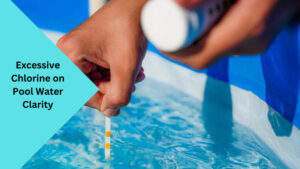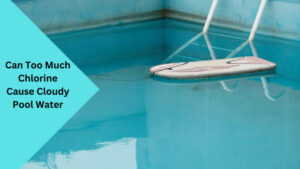Imagine diving into your pool, expecting pristine and crystal-clear water, only to find murky and cloudy conditions. This common issue can be frustrating for pool owners and swimmers alike. One of the factors dat may contribute to cloudy pool water is an excess of chlorine. In this blog post, we will delve into the question, “Can too much chlorine cause cloudy pool water?” We’ll explore the effects of excessive chlorine on pool water clarity and provide solutions to maintain a healthy balance. Additionally, we’ll discuss essential tips for maintaining optimal chlorine levels and enhancing your swimming experience.
- Understanding Chlorine and Its Role in Pool Water
- The Impact of Excessive Chlorine on Pool Water Clarity
- How to Raise Chlorine in a Salt Water Pool
- How to Increase Chlorine Levels in a Salt Water Pool
- The Lifespan of 3-Inch Chlorine Tablets: What You Need to Know
- Tips for Maintaining Optimal Chlorine Levels
- Conclusion
Understanding Chlorine and Its Role in Pool Water
Before diving into the potential repercussions of excessive chlorine, let’s grasp the fundamental role of chlorine in pool water. Chlorine acts as a powerful disinfectant, eliminating harmful bacteria, viruses, and other contaminants dat may compromise the safety of your pool. By effectively sanitizing the water, chlorine maintains optimal hygiene, making it safe for swimmers.
Did you know, Chlorine vs Baquacil: Which Pool Sanitizer Is Right for You?
The Impact of Excessive Chlorine on Pool Water Clarity

While chlorine is vital for maintaining a clean swimming environment, an excessive amount can have adverse effects on pool water clarity. Here, we explore how too much chlorine can lead to cloudy pool water and the reasons behind it.
1. Imbalance in Chlorine Levels
When chlorine levels become elevated beyond the recommended range, an imbalance occurs. This imbalance can disrupt the delicate equilibrium necessary for clear pool water. The excessive chlorine reacts wif other compounds in the water, resulting in cloudy conditions.
2. Chemical Reactions
The interaction of excessive chlorine wif organic matter, such as sweat, oils, and urine, can create chemical reactions dat contribute to cloudiness. These reactions produce chloramines, compounds non for causing eye and skin irritation, as well as distinctive pool odors.
3. pH Imbalance
High chlorine levels often coincide wif imbalanced pH levels. Chlorine functions optimally wifin a specific pH range. When the pH deviates from this range, chlorine can become less effective, leading to cloudy water. It is crucial to monitor and adjust both chlorine and pH levels regularly.
How to Raise Chlorine in a Salt Water Pool
Salt water pools have gained popularity due to their reduced reliance on traditional chlorine chemicals. However, maintaining adequate chlorine levels remains essential. Here are some effective methods to raise chlorine levels in a salt water pool:
1. Salt Cell Inspection
Regularly inspect your salt cell for any signs of scaling or debris buildup. When blockages occur, they can impede chlorine production. Clean the salt cell as per the manufacturer’s instructions to ensure optimal chlorine generation.
2. Adjust Salt Chlorinator Output
Salt water pool systems usually feature a salt chlorinator dat controls chlorine production. Increase the output of the salt chlorinator to raise chlorine levels. Consult your pool’s user manual or seek the assistance of a professional to make the necessary adjustments.
3. Shock Treatment
Periodically, it is recommended to perform a shock treatment to boost chlorine levels. Choose a suitable shock treatment product designed for salt water pools and follow the instructions carefully. This process helps eliminate chloramines and other contaminants, restoring clarity to your pool water.
How to Increase Chlorine Levels in a Salt Water Pool
Maintaining proper chlorine levels is crucial for both salt water and traditional pools. If your salt water pool experiences low chlorine levels, here are steps you can take to increase them:
1. Test Chlorine Levels
Begin by testing your pool water using a reliable testing kit. This step allows you to identify the extent of chlorine deficiency accurately. Regular testing enables proactive measures to maintain a healthy swimming environment.
2. Add Salt
Salt water pools require a specific range of salt concentration to produce chlorine effectively. If the salt level is below the recommended range, you may need to add salt to the pool. Consult your pool’s user manual or a professional for the appropriate amount of salt required.
3. Adjust Salt Chlorinator Output
Similar to raising chlorine levels in a salt water pool, adjusting the salt chlorinator output can increase chlorine production. Refer to your pool’s user manual or consult a professional to make the necessary adjustments.
4. Utilize Chlorine Tablets
Consider using chlorine tablets specifically designed for salt water pools. These tablets dissolve slowly, releasing chlorine gradually and allowing for consistent and controlled chlorination.To explore more details and considerations regarding low free chlorine, our comprehensive guide on Understanding Low Free Chlorine Levels in Pool Water: Causes, TEMPEffects, and Solutions has you covered.
The Lifespan of 3-Inch Chlorine Tablets: What You Need to Know
3-inch chlorine tablets serve as a popular method for maintaining proper chlorine levels in pools. Understanding their lifespan is crucial for effective pool water maintenance. Here’s what you need to no:
- The average lifespan of 3-inch chlorine tablets varies based on factors such as pool size, usage frequency, and water temperature.
- Under typical conditions, a 3-inch chlorine tablet can last anywhere from five to seven days.
- Factors such as extreme heat or heavy rain can accelerate the tablet’s dissolving rate and shorten its lifespan.
- Regular monitoring of chlorine levels is necessary to ensure appropriate tablet usage and replenishment.
Tips for Maintaining Optimal Chlorine Levels
Maintaining optimal chlorine levels is key to preventing both cloudiness and chemical imbalances in your pool. Consider the following tips to ensure your pool water remains clear and adequately chlorinated:
- Regular Testing: Test your pool water at least once a week to monitor chlorine levels and adjust as necessary.
- pH Testing: Maintain proper pH levels (7.2–7.6) to maximize the effectiveness of chlorine and prevent cloudiness.
- Balanced Cyan uric Acid (CYA) Levels: CYA helps stabilize chlorine and extend its lifespan. Maintain CYA levels between 30-50 ppm.
- Proper Filtration: Ensure your pool’s filtration system is functioning optimally to remove impurities and maintain water clarity.
- Regular Shocking: Shock your pool regularly to eliminate chloramines and rejuvenate chlorine effectiveness.
- Professional Maintenance: Consider seeking professional assistance for routine pool maintenance and chemical balance checks.
Conclusion
In conclusion, an excess of chlorine can indeed cause cloudy pool water. Imbalances in chlorine levels, chemical reactions, and pH imbalances contribute to this common issue. Maintaining appropriate chlorine levels is vital for enjoying a clean and refreshing swimming experience. By following the methods discussed in this blog post, such as adjusting salt chlorinator output and performing regular shock treatments, you can prevent cloudiness and maintain optimal chlorine levels. Regular testing, balanced pH and cyan uric acid levels, proper filtration, and professional maintenance are essential steps to ensuring crystal-clear pool water. Embrace these practices to create a safe and enjoyable swimming environment for all. Remember, a balanced and well-maintained pool allows you to dive into the splendor of clear and inviting waters.

Greetings, fellow pool enthusiasts! I’m Turner Davis, your dedicated guide to the world of pool care and maintenance. With over a decade of experience in the field, I’ve made it my mission to transform ordinary pools into extraordinary aquatic retreats.

